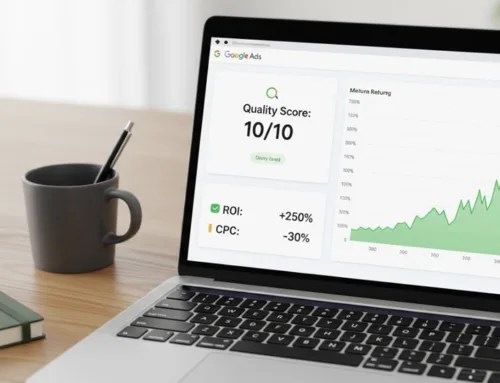Trying to compare the results of a Facebook Ads campaign with those generated by Google Analytics can be maddening! Significant discrepancies can be found in the statistics, casting doubt on the credibility of either or both of the tracking systems. But rather than questioning the reliability of the results, we need to look elsewhere for the truth.
There are, in fact, a multitude of reasons for these discrepancies. They essentially stem from a difference in approach to the tracking systems used by each of them. Google uses cookies based on browsing history, and this model places great value on the last click. Facebook social ads, on the other hand, uses tracking pixels based on the user (User ID) and is interested in the behavior of Internet users in relation to a brand (people-centric method). Here’s a review of the main differences.
Multi-device conversions
Case study: A person is exposed to an advert and clicks on it in the morning using a computer, then is re-exposed in the evening and buys using their cell phone.
– What Facebook sees
Whether a person uses Facebook on computer, tablet or mobile, they are personally identified by Facebook via their account, even if they change devices in their purchasing journey. Conversions can therefore be tracked more precisely in reports.
– What Google Analytics sees
With a cookie-based tracking system, Google Analytics cannot fully measure conversion, as it cannot establish a link between different devices. As a result, conversions on mobile devices are underestimated by Google Analytics.
Clicks and impressions
Case study: A person sees a Facebook ad but doesn’t click on it. Later, they visit the website and make a purchase.
– What Facebook sees
Facebook identifies that the sale was made after seeing an ad. Conversion is therefore associated with advertising.
– What Google Analytics sees
For Google Analytics, it’s impossible to detect that the person has seen the ad. So it won’t make the connection at the point of conversion.
Clicks and sessions
Case study: A person clicks repeatedly on an advertisement.
– What Facebook sees
Facebook highlights the number of clicks, i.e. the number of times the ad has been clicked by the visitor.
– What Google Analytics sees
If the clicks were made during the same session, Google Analytics only counts one session.
Last click
Case study: A person clicks on an ad, visits, leaves your site, and then returns to make a conversion.
– What Facebook sees
Facebook tracks conversions from one device to another, and can also track non-linear conversions, so the sale will be associated with the click on the ad. To track these conversions, Facebook has a 24-hour attribution window that records the number of views (post view) and a 28-day window that identifies clicks (post click).
– What Google Analytics sees
By default, Google Analytics only identifies conversions from direct recommendations. It only tracks last clicks or linear conversions, i.e. when the customer has clicked on an ad and immediately converted. In this case, Google Analytics does not associate the sale with the click on the ad. However, it is possible to see the contributory role of Facebook Ads thanks to the multi-channel funnels offered by Google Analytics.
Referring URLs
Case study: A person clicks on an ad on Facebook (using HTTPS protocol) and generates a conversion on a site (HTTP).
– What Facebook sees
Facebook takes care of tracking the entire operation and attributes the sale to the click on the ad.
– What Google Analytics sees
Google Analytics uses referring URLs to track conversions after exposure to an ad. But according to Facebook, 40% of the social network’s subscribers are active using the HTTPS protocol rather than HTTP. Google Analytics cannot record the referring link when a person leaves an HTTPS environment (Facebook) to enter an HTTP environment (shopping site). The click on the advertisement and the sale cannot therefore be associated.
Tip:
Google Analytics doesn’t recognize the source of traffic coming from Facebook, nor the keywords users click on. It therefore categorizes all Facebook ad traffic as direct traffic. To overcome this shortcoming, you can modify the Google Analytics tracking script. To begin with, you need to create a specific URL from Google URL Builder in the following form:
http://www.exemple.com/?utm_source=facebook&utm_medium=cpc&utm_campaign=avril_2017
Next, you need to modify the Google Analytics script on your site by adding the lines marked in red below:
<script type=”text/javascript”>
var _gaq = _gaq || [];
_gaq.push([‘_setAccount’, ‘UA-123456789-1’]);
_gaq.push([‘_setCampSourceKey’, ‘utm_source’]);
_gaq.push([‘_setCampMediumKey’, ‘utm_medium’]);
_gaq.push([‘_setCampNameKey’, ‘utm_campaign’]);
_gaq.push([‘_trackPageview’]);
(function() {
var ga = document.createElement(‘script’); ga.type = ‘text/javascript’; ga.async = true;
ga.src = (‘https:’ == document.location.protocol ? ‘https://ssl’ : ‘http://www’) + ‘.google-analytics.com/ga.js’;
var s = document.getElementsByTagName(‘script’)[0]; s.parentNode.insertBefore(ga, s);
})();
</script>
Google Analytics will be able to identify the source, campaign and keywords for your Facebook Ads traffic.
Mis à jour le 30 April 2025
Mis à jour le 30 April 2025




